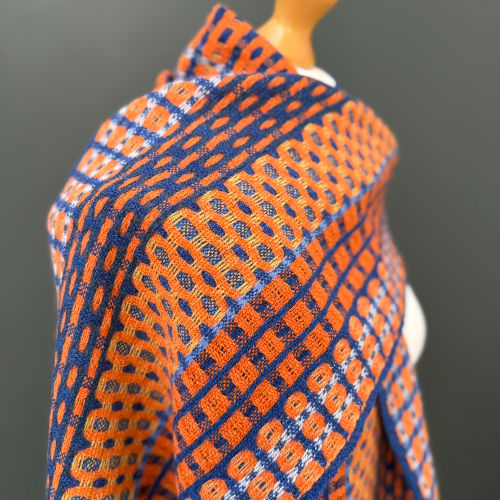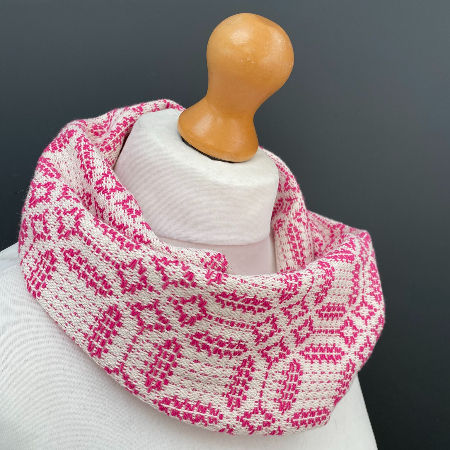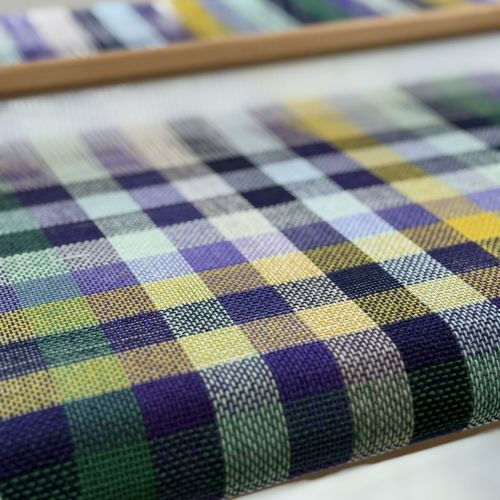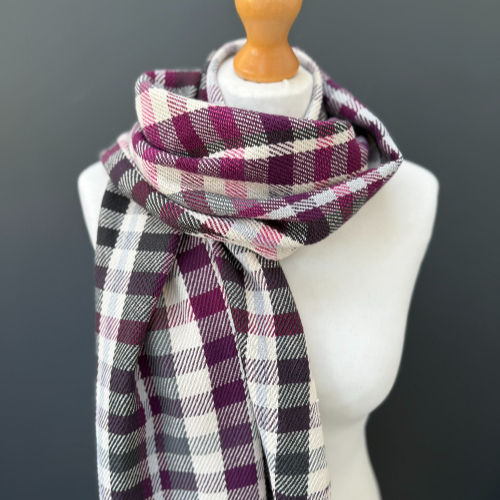Choosing a suitable weaving structure when creating handwoven designer scarves, snoods and shawls
- Emma Baker

- Jul 30
- 7 min read
Updated: Aug 23
Introduction - weaving structures of luxury designer handwoven scarves, snood and other accessories
Every weaving structure has a personality. Some can be woven on a rigid heddle loom with just two shafts, others on a table or floor loom with a greater number of shafts. The structure of a weave along with the yarn used together shape the final weave with respect to the drape, texture, durability and how the light plays across the surface to give the overall impact. I have woven several different weaving structures when creating collections of designer handwoven scarves, snoods and shawls and this blog discusses some of them. Each weaving structure is outlined with what makes it unique and the design influences the final look and feel of the woven accessory.
Plain weave - Tabby weave is perfect for the rigid heddle weaving loom
Plain weave is the simplest balanced weave. The warp and the weft threads alternate over and under each other like a basic basket pattern. It creates a strong, durable fabric with a smooth even texture.
Because of its simplicity I often choose to weave a plain tabby weave with my hand spun yarn. My thinking here is that with a hand spun yarn no fancy pattern or design is needed to distract from the beautiful fibres.
Colour and Weave designs are still plain weave so are perfect for rigid heddle loom weavers
Plain weave doesn't just need to be woven with the same warp and weft yarn. I think that one of the most interesting things about weaving is the way that our eyes mix or visually blend the colours in the warp and the weft yarns. Colour and Weave refers to weaving where contrasting yarn colours are used in the warp and the weft. Where the alternative threads have a large contrast a striking visual effect is seen.
The scarf below was woven on a floor loom with a solid pink and white yarn with a hand dyed pink and lilac speckled yarn. You can read about the project to weave this scarf in another blog: Textile design - weaving a commission pink merino wool scarf.
I have woven a number of colour and weave designs and some are detailed below.
A houndstooth weave creates a timeless classic designer scarf
A classic houndstooth design creates a stunning pattern in a handwoven scarf. It is known for its bold, broken check design that resembles the jagged teeth of a hound. Traditionally it is woven using a simple twill 2/2 structure but a variation is woven in plain weave. New weavers are often amazed at how this pattern can be created by the repeating pattern of two threads in one colour followed by two in another colour with this design replicated in both the warp and the weft threads.
The scarf below was woven on a rigid heddle weaving loom using 4 ply navy and 4 ply light grey cotton yarn.
Log cabin weaving is a sharp visual contrast pattern
The interplay of the colours and the geometric pattern of a log cabin design adds visual interest to a woven piece. The name 'log cabin' comes from the resemblance of the pattern to the logs used in the construction of log cabins. In the log cabin weave, two contrasting colours of yarn are used to create the pattern. One colour represents the 'light logs' and the other colour represents the 'dark logs'. The pattern can be adapted to different sizes and proportions, making it a versatile design for various projects. To create the design the weaver alternates between the two colours of yarn, weaving a set number of rows for each colour to achieve the desired log height. As the piece is woven it creates the illusion of logs stacked on top of each other.
The scarf below was woven using a Falkland wool and silk West Yorkshire Spinners Exquisite 4 ply yarn.

The 2/2 Twill weave creates a diagonal balanced weave structure
Twill is recognised by its diagonal lines or ridges created by shifting the warp and the weft in a stepped pattern. The 2/2 denotes the ratio between the warp and the weft creating a balanced weave which looks the same on either side of the woven fabric. This weave is created when each weft thread passes over two warp threads, then under two, creating a balanced diagonal pattern. This weave makes a scarf or shawl with a beautiful drape that is more resistant to wrinkling than plain weave. There are various twill weave structures with diagonal, diamond or herringbone structures being possible.

The weave above was woven to create the stunning cotton shawl shown here:
Tartan Weaving
Tartan is a classic woven pattern that is instantly recognisable by its crossing bands of colour, forming a grid of checks or plaids. Traditionally associated with the Scottish Heritage, each Tartan design is created by repeating a specific sequence of coloured threads both in the warp and the weft. Where these sequences intersect they form layered squares of mixed colour which gives the Tartan its design. A Tartan handwoven scarf is usually woven with a twill design creating a characterful statement accessory which is deeply rooted in textile heritage. You can read a blog about a Tartan weaving project I did to weave a family Tartan as a special gift by clicking here: The 7 steps involved in creating and weaving a beautiful designer handmade handwoven family tartan shawl
A reverse twill
A reverse twill is another variation of twill weaving. In the regular 2/2 twill, each weft thread passes over two warp threads, then under 2 creating a balanced diagonal pattern. With a reverse twill, the direction of the diagonal changes at planned intervals resulting in a mirrored or zigzag effect. This reversal adds visual interest in a scarf with the different areas of the weave catching the light beautifully.
In the snood shown below you can see that the angle of the weft varies across the cotton weave.
Turned 3/1 and 1/3 Twill
A turned 3/1 and 1/3 twill is a beautiful example of how subtle structural changes in a woven fabric can dramatically affect the look and feel of a woven cloth. In a standard 3/1 twill the weft thread floats over three warp threads and goes under one creating a smooth surface with strong diagonal lines. When this is turned, the roles of the warp and the weft are reversed so in a 3/1 twill, the warp floats over the weft, producing a cloth that looks similar but behaves differently. By alternating between the two different twill sections the weaver creates areas of cloth which have contrasting textures and light reflectivity.
The scarf shown below was woven with this interesting structure.
Straight 8 patterns
I have an 8 shaft floor loom and one of the easiest designs is to thread the heddle in a straight 8. This means that the first warp thread goes through a heddle on shaft 1, the second on shaft 2 etc. Once the 8th thread has been threaded onto the 8th heddle the threading pattern of 8 is repeated across the warp. There are then a number of different lifting patterns which can be used to create different designs as shown in the image below.

Monk's Belt Weaving
Monk's belt is a traditional block weave known for its bold, geometric patterns and striking visual contrast. It combines areas of plain weave and supplementary weft floats that create decorative motifs, often squares, stripes or stepped shapes. When weaving this design you need to use pattern weft floats which form the pattern with finer ground weave weft rows which hold the fabric structure. In the examples shown below the patterned weft was a pale grey cotton yarn with a very fine ecru cotton yarn woven with a tabby weave which alternates between the patterned weft rows. You can read more about the weaving of this design in another blog where the focus of the article was on the time taken to weave the design and create a handwoven scarf. Click here to read the blog: How long does it take to weave a handmade handwoven designer scarf?

Doubleweaving
Doubleweave is a really interesting weaving technique that allows two layers of fabric to be woven simultaneously. The layers can be completely separate, joined at the edges to form a tube or interconnected in creative ways to form reversible patterns. Because the woven fabric has two layers it can result in a thick fabric without much drape. In the weave below I knew that I wanted to use the fabric for luxury snoods so it was woven with fine merino lace yarn so that even the doublecloth was relatively fine and drapey. In the image below you can see that the fabric is reversible.

Deflected doubleweaving
Deflected doubleweave is a weave structure that involves two layers of cloth that interconnect at selected points. Unlike traditional doubleweave, deflected doubleweave allows threads from one layer to 'float' into the other, creating fluid, organic shapes and a lightweight airy fabric. It is given its name because it has two similar but distinct patterns on either side of the cloth hence the term doubleweave. Deflected because the design incorporates long warp and weft floats which shrink and full differently to the tabby areas of the weave. When taken off the loom and washed the fabric shrinks differently in the float and tabby weave areas leading to a deflection and softening of the pattern edges.
The images below show a recent weave with a deflected doubleweaving structure to create a collection of luxury designer scarves, snoods and shawls.



Overshot
Overshot is a classic American weaving structure known for its intricate often floral or geometric patterns that seem to float over the plain weave background. Like Monk's Belt it is woven using two wefts, a fine ground weft that weaves the plain tabby pattern and a pattern weft which creates the decorative design. These designs are typically woven on 4 shafts using a system of blocks. You can read more about an Overshot weaving project that I did in this blog: Mastering Overshot Weaving
Whilst I have woven a number of Overshot projects to make decorative table runners and table mats I have also woven a few luxury scarves and snoods. The snood below was woven using a pink patterned weft.

Summary
Each weaving design brings its own personality chosen by the weaver for how it looks but also for how it feels, drapes and catches the light. Each of these designs also relies on practised craftsmanship. While the finished fabric may look effortless, weaving these structures is a deeply skilled and sometimes painstaking process. Each pattern requires careful planning before the weaving even begins with optimisation often required to ensure that the structure is woven perfectly at the correct sett for the particular yarn that is being used. Getting it right requires hours of practise and experimentation and a deep understanding of both the structure and the yarn being used. It is for this reason that when a handwoven scarf, snood or table runner is purchased it is an investment in the time honoured skills of the weaver.
My handwoven scarves and snoods are available for purchase in my website for UK delivery.
If you are interested in knowing what is on the loom, off the loom and workshop dates then do sign up to receive my weaving news emails by clicking here.
















